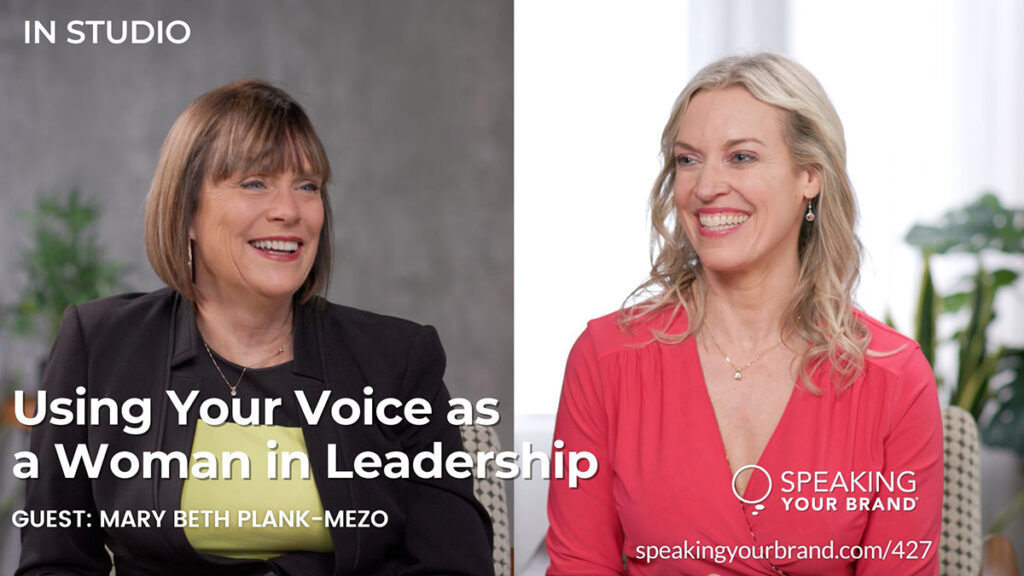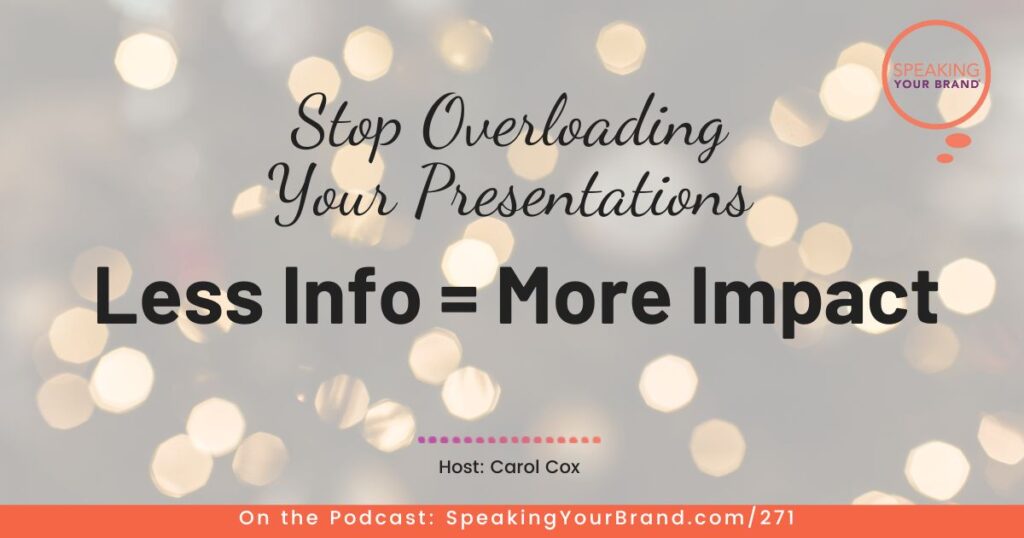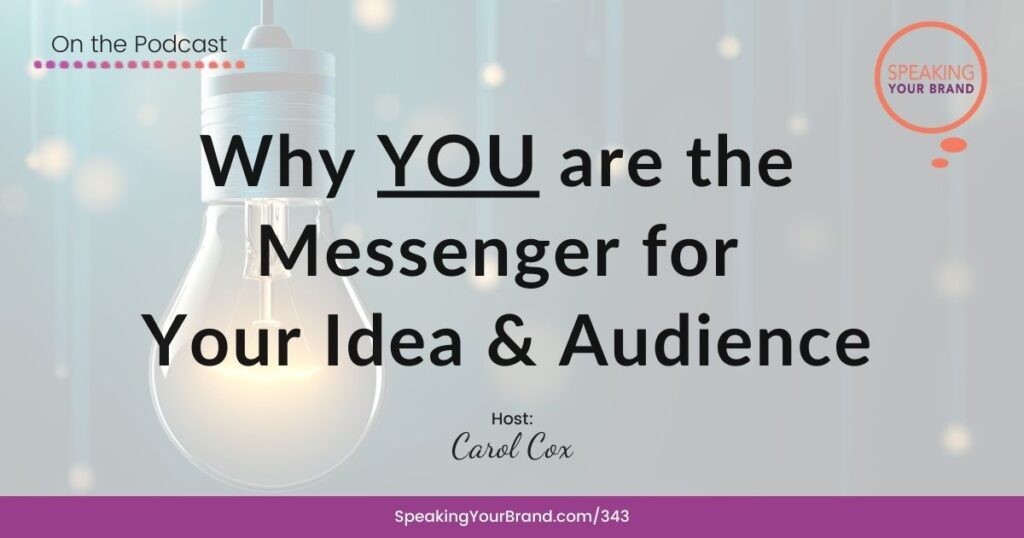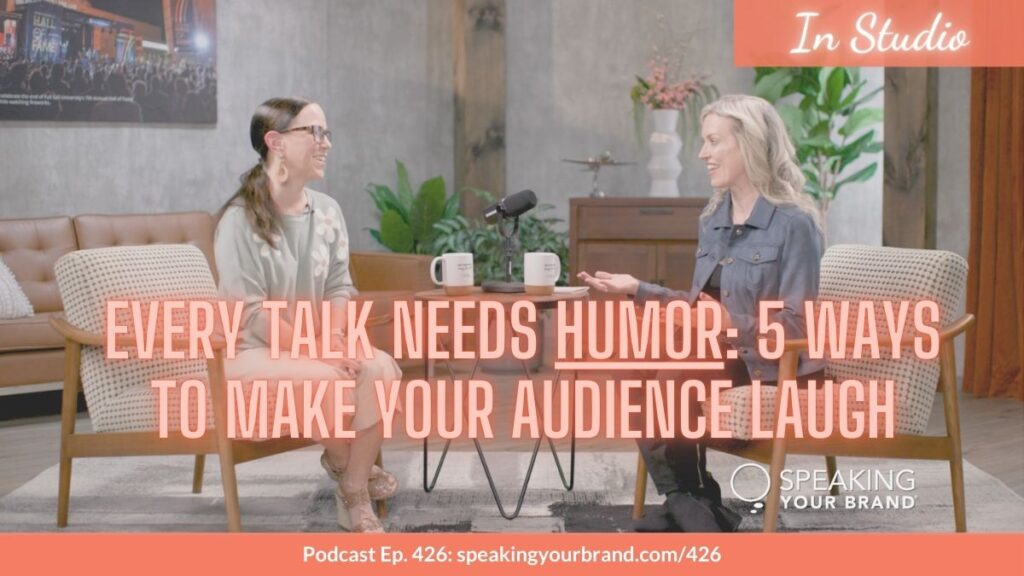Break the Fourth Wall: Lessons from the Olympics, Kamala, and Shakespeare with Carol Cox: Podcast Ep 404
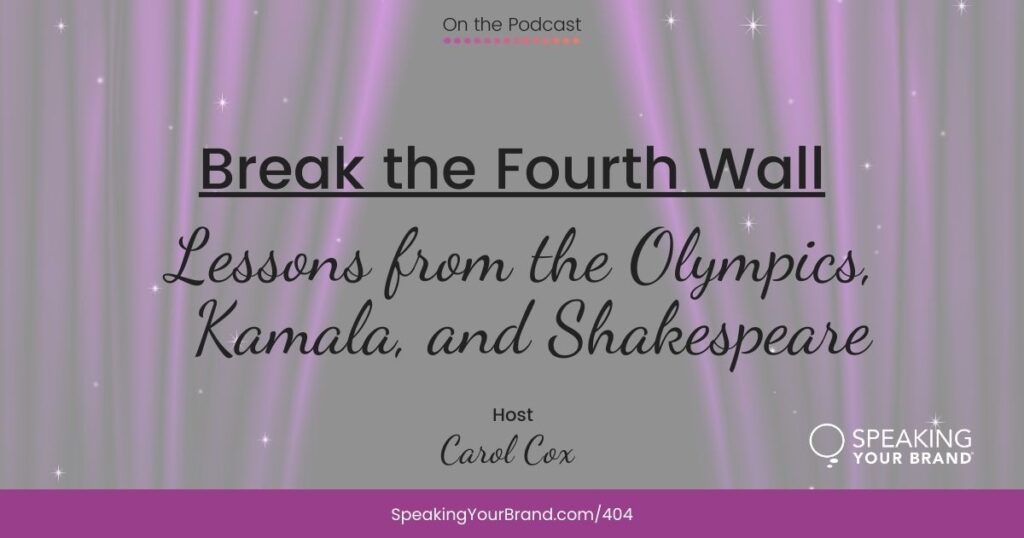
Subscribe to the podcast!
This is going to be a fun episode and hopefully get you thinking differently about the presentations and talks you give, whether you’re speaking to audiences of 20, 50, 100, 500, or more.
What does it mean to “break the fourth wall” and should you do that as a speaker?
The fourth wall is the imaginary wall at the front of the stage that separates the fictional world (the performance) from real life (the audience).
When you attend a play or a movie, you’re an outsider watching the characters live their lives; they don’t know you exist.
However, I’ve noticed more and more that live performances and even movies are breaking the fourth wall.
What does this have to do with you as a speaker?
That’s what we’re going to talk about, including specific things you can do to break the fourth wall with your audience to be a more impactful and memorable speaker.
About Us: The Speaking Your Brand podcast is hosted by Carol Cox. At Speaking Your Brand, we help women entrepreneurs and professionals clarify their brand message and story, create their signature talks, and develop their thought leadership platforms. Our mission is to get more women in positions of influence and power because it’s through women’s stories, voices, and visibility that we challenge the status quo and change existing systems. Check out our coaching programs at https://www.speakingyourbrand.com.
Links:
Show notes at https://www.speakingyourbrand.com/404/
Discover your Speaker Archetype by taking our free quiz at https://www.speakingyourbrand.com/quiz/
Attend our 1-day Speaking for Impact in-person workshop in Orlando: https://www.speakingyourbrand.com/workshop/
Enroll in our Thought Leader Academy: https://www.speakingyourbrand.com/academy/
Connect on LinkedIn: https://www.linkedin.com/in/carolcox
Related Podcast Episodes:
- Episode 393: The Kind of Speakers that Get the Best Feedback and Referrals
- Episode 345: Elevate Your Audience Engagement Skills with These Proven Strategies
- Episode 249: The Relationship Between Speaking and Performance
404-SYB-Solo-Fourth-Wall.mp3: Audio automatically transcribed by Sonix
404-SYB-Solo-Fourth-Wall.mp3: this mp3 audio file was automatically transcribed by Sonix with the best speech-to-text algorithms. This transcript may contain errors.
Carol Cox:
Are you breaking the fourth wall as a speaker? Here’s why you should do it and how. On this episode of the Speaking Your Brand podcast. More and more women are making an impact by starting businesses, running for office, and speaking up for what matters. With my background as a TV political analyst, entrepreneur, and speaker, I interview and coach purpose driven women to shape their brands, grow their companies, and become recognized as influencers in their field. This is speaking your brand, your place to learn how to persuasively communicate your message to your audience. Hi there and welcome to the Speaking Your Brand podcast. I’m your host, Carol Cox. This is going to be a fun episode and hopefully get you thinking differently about the presentations and talks you give, no matter the topic, no matter the industry, no matter if you’re speaking to audiences of 20, 50, 100, 500 people or more. So what exactly is this fourth wall and what does it mean to break it? And should you even do that as a speaker? And if so, what does that look like? Well, the fourth wall is the imaginary wall at the front of the stage that separates the fictional world, which is the performance that’s happening on the stage from real life, which is us as the audience sitting there in the theater. When you attend a play or even a movie, you’re an outsider in the audience, watching the characters live their lives on the stage or on the screen.
Carol Cox:
They don’t know you exist. And that’s the way theater has been done, at least contemporary theater and contemporary movies for a long time. However, I’ve noticed recently that more and more plays, live performances, and even movies are breaking this fourth wall between the fictional world of performers and us, the audience in real life. I recently did a whirlwind ten day trip to Europe. We went to four cities in ten days. It was like our mini Amazing Race and we went to London, Edinburgh, Amsterdam and Paris. And while we were there we went to four different shows. So I’m going to talk about what I’ve noticed about these shows. Some of them broke the fourth wall and some of them didn’t, and the impact that it had on us as the audience. I’m also going to talk about the opening ceremony of the Paris Olympics, and the recent energy and enthusiasm for Kamala Harris’s campaign for president. Now, you may be wondering, what do these shows and the Olympics opening ceremony and Kamala Harris’s campaign have to do with you as a speaker? Well, that’s exactly what we’re going to talk about, because I want you to break the fourth wall in your presentations and talks, because that’s how you’re going to be a more impactful speaker and a more memorable one, which will get you more leads for your business and referrals for more speaking opportunities.
Carol Cox:
Now, strategies like breaking the fourth wall are just one example of how we work with you to uplevel your speaking skills. Whether it’s in our online Thought Leader Academy or in our in-person workshops. Right now, we’re enrolling for our Thought Leader Academy. You work with us to get clarity on all of your ideas, to develop your thought leadership message, and to get your signature talk created. We guarantee it. We do the work with you. You’re not left to do it by yourself. And we know that you have a lot going on, which is why you do the work with us in that one on one VIP day, where we sit down together for three hours on zoom, and we create your talk from beginning to end using our proven framework. And during those weekly group calls where you’re with the other women who are in the program so that you do the work during all of those calls. So expect to spend about 1 to 2 hours per week. Again, we know that you have a lot going on, which is why we have really streamlined and accelerated the process to get you the results that you want. Here’s a couple of examples of women who’ve graduated from our Thought Leader Academy. One of them is Karen Keen, who was on the podcast last summer, and she said that I know first hand how well Carol and Diane helped women tell their stories on the big stage with confidence, clarity and meaningful impact.
Carol Cox:
Last year, I worked with them in the Thought Leader Academy to develop my keynote speech, and I received a standing ovation. Here’s what one of our other Thought Leader Academy grads, Angela Crawford, said. She said that our signature talk framework is incredibly powerful going through this process, and the Thought Leader Academy helped me create my own framework and signature talk to share my message in an engaging and impactful way. Carol and Diane teach and model how to go beyond sharing information to creating transformation. This is what we want for you too. You can get all the details about our Thought Leader Academy, and you can schedule a zoom call with us by going to speaking your brand.com/academy. Again, that’s speaking your brand.com/academy. Now let’s get on with the show. Let’s dig in to what this fourth wall is, and why it’s important for you as a speaker to break it with your audiences. The fourth wall is that imaginary wall that’s at the front of the stage that separates the fictional world. So that’s the performers who are on the stage or on the screen from real life, which is all of us in the audience. When you attend a play or performance or you’re watching a movie as the audience, you’re an outsider watching the characters live their lives.
Carol Cox:
They don’t know that you exist. And that’s really been the premise of theaters and movies for a long time. However, as I said in the intro, I’ve noticed that more and more plays, performances, and movies are breaking the fourth wall. So let me give you an example and then why they’re doing this. If you watch the Barbie movie that came out last summer, there’s a part in the movie where the narrator, who’s played by Helen Mirren, makes an aside to the filmmakers about their choice to cast Margot Robbie as Barbie. There’s a scene where Barbie is crying, and she says something to the effect of, I’m not that pretty. I don’t look like a stereotypical Barbie. Now, you know when Margot Robbie looks like, especially in the Barbie movie, she looks exactly like a stereotypical Barbie. So us as the film goers, the audience, we’re probably thinking to ourselves, ah, really, you are beautiful and you look just like a stereotypical Barbie. So Helen Mirren cuts in on that scene as a narrator and says, note to the filmmakers, Margot Robbie is not the person you would cast. If you want to make this point, not only is it funny, but also it lets us, the audience, know that they get it like they understand how ridiculous it is for Margot Robbie playing Barbie to have said that line.
Carol Cox:
So why are performances and movies doing this? My hunch is that first, audiences desire more interactivity. We want to be more involved in the experience. Think about social media. We are co-creators of so much of what we see online. It’s also fun to feel in the know. Like that example from the Barbie movie where we’re watching it. We’re like, uh, of course, uh, Margot Robbie looks like a stereotypical Barbie. And if they had an addressed it, it would have felt, well, weird and incongruent. But when they do address it, it makes us feel like we’re in the know. Audiences are much more sophisticated nowadays than they ever have been. So what does this have to do with you as a speaker? Your audiences are also more sophisticated than they have been in the past. They want acknowledgement of what they already know, and they want acknowledgement of what they’re already thinking, and they want to be part of the experience. I’m going to share with you examples of what I’ve noticed recently, and what we can take away from them as speakers. So specific strategies you can do. First, let’s talk about Kamala Harris. Wow, what a turn of events. It feels like a year of news happened in a week, and I am so excited to see how much energy and enthusiasm has sprung up on the internet, but also in real life.
Carol Cox:
So many of us just took a big sigh of relief. We were allowed to like, exhale and feel hope. We could feel hope once again. And all these Kamala memes that are going around, people doing TikTok match ups of coconut trees and Charli Xcx’s Bratz song. It’s been fun. I think that’s what we’ve been longing for for so many years. We just want to be able to have fun. And also there’s this feeling of collective effervescence. Collective effervescence is when people come together and they start synchronizing like they start getting in sync. You see this at concerts when people are dancing and singing together. And that’s why I think Taylor Swift’s concerts have also been so successful. People are longing for this sense of collective effervescence. Just in the week since, Kamala Harris has become the presumptive Democratic nominee for president, her campaign has raised over $200 million. Unbelievable. Tens of thousands of volunteers have signed up, so clearly this energy and enthusiasm has been there. It’s just been waiting to have an outlet. Also, if you think about these Kamala memes like the coconut trees and her love of Venn diagrams, it’s really about people embracing her authenticity, but also about Kamala Harris being willing to be authentic, being willing to be a little quirky, and to embrace those quirky aspects of her personality. And I have more on this idea of authenticity coming up in an episode in a couple of weeks.
Carol Cox:
The next example is that when we were in Amsterdam, we went to see pink in concert. I have been following pink probably since the mid 2000. I love so many of her songs. We happen to be in Amsterdam the same time that she was holding her concert. So we said, okay, sure, let’s go ahead and go. It was in one of their football arenas and it was so much fun. So of course it’s an incredible show. Dancers and acrobats. And she does acrobatic moves herself. And she’s been doing that for a number of years. But she and she still does them and it’s so impressive. And it’s just and talk about fun. It was just a lot of fun. It’s called Summer Carnival. That’s the concert tour she’s doing right now, and it’s a lot of fun. But what’s great about pink is that she’s so real, she’s so authentic, she’s so relatable that during a couple of parts of the two hour plus show, there was there was one part where she came back out after a costume change, and she basically came out and said, okay, my costume is not snapped all the way because we couldn’t get it to snap in time before I had to come back out here. So I’m feeling a little weird right now and it was just so funny. It was so relatable that at one point she was really sweaty and she’s like, can someone please get me a towel? So when you know, someone on the side of the stage got her a towel, right? And it’s like, that is real life.
Carol Cox:
Like real life is not perfect and airbrushed and not everything goes off exactly like you want it to, like. Stuff happens. It makes me love her. And that experience, being at that concert even more, she also interacted with people in the audience and the gifts that they have brought with her. So she would see that they were holding up gifts and she would go, and now she wouldn’t just take the gift and then just kind of put it on the side of the stage. She would actually start having a conversation with them about their gift and all this stuff. So it was just it was a lot of fun. I know lots of other artists do this too, and I feel like the reason they do this is because audience are expecting to feel more a part of the experience. When we were in London, we went to see a Shakespeare play at the globe, which is the reproduction of the original Globe Theatre that Shakespeare actually performed in way back circa 1600. The play that was on was Much Ado About Nothing. It is so playful. It is so fun. It is so funny.
Carol Cox:
And I think a lot of times when we were in school and we had to study Shakespeare and we just had to read it on the page, obviously the language feels really odd. It feels dense because it’s not the way that we talk nowadays, and a lot of the humor doesn’t come across for some of for his comedies. But this production of a Shakespeare play was the best we’ve ever seen, and we have seen a lot over the years. We’ve probably seen at least 30 Shakespeare productions, and this by far was the best actors were coming through the different kind of floor part of the audience with, with, uh, props. As they were coming up onto the stage, they were interacting directly with people in the audience. They were singing, there was dancing. It was so fun. Again. It was so funny. It really felt like how it was when Shakespeare was alive and people would go see the plays. Then I feel like we’ve lost so much of that authentic audience engagement. When we were in London, we also went to the opening night of the musical hello, Dolly! In the Western Theatre District, the star is Imelda Staunton, who played the Queen in the last few seasons of The Crown. So extraordinary actor and singer and performer now, this musical was technically perfect. Impressive stage production. There is parts of the stage that removing every actor was perfectly choreographed and exactly the spot that they needed to be in, and again, it was technically perfect, but it lacked, to me at least, heart and soul.
Carol Cox:
It felt sterile. So even though I was impressed with their performances and the acting and the singing and the dancing and all of the technical wizardry, we might as well have been watching a film on a screen now. I still love theatre and plays, and I like being in the audience. And there is something different about being at a live performance versus watching a film. But I just feel like there was so much distance, like there was the lack of intimacy between us as the audience and what was going on on the stage. Now contrast this with the musical called And Julia that I saw on Broadway in New York last year. It’s a take on the Romeo and Juliet storyline, except Julia is the center character instead of Romeo, and it’s really done a lot of it from her perspective. And at the very beginning of that performance, the performers addressed the audience directly. They actually talked to us as the audience to let us know that they know that we exist, and we’re all in on this together. So again, as I mentioned, this idea of the fourth wall is that there’s the fictional world on the stage. There’s us, the audience in real life, but neither the twain shall meet.
Carol Cox:
So the performers on the stage never acknowledge the audience. But you’re starting to see that they’re doing that now. Again, I think it’s because, number one, audiences really want this interactivity. But number two, because they know audiences are sophisticated and they want to be acknowledged that they’re there. The last example that I want to mention before we get into specific strategies you can use is the opening ceremony of the Paris Olympics. Now, I was just in Paris for Bastille Day, July 14th, which I absolutely love. My master’s degree, my PhD dissertation are in French history. I’ve been to Paris four times now. I love the city. I love walking around the city. I was really rooting for them. For the opening ceremony, there was a behind the scenes documentary that I had watched about everything that was being put together for the opening ceremony, and I loved that the organizing committee wanted to be creative and different and use the river scene to showcase the beautiful architecture and art and history of Paris. So I loved all that. But as I was watching the opening ceremony, it felt like a film production, which is fine, but that’s not really what an opening ceremony of the Olympics is supposed to be. Now, of course, the rain did not help. I felt so bad for them, but it was more than that.
Carol Cox:
What makes the Olympics, especially that opening ceremony so special, is the interaction and integration of everyone who is there, the athletes as well as the audience. It’s supposed to be a big party, plus a concert, plus a welcome to the athletes. So what was missing from this opening ceremony was that collective effervescence of all the athletes from all of the countries together being in the same physical space, cheering each other on and just having that sense of the collective. So now that I’ve given you these varied examples of performances and plays and movies that have broken the fourth wall, plus what it looks like when they don’t, here are some specific things you can do in your presentations and your talks. Number one, bring humor and fun. Your audiences are longing to laugh and to bond with each other. No matter your topic, there is always a place for appropriate humor. And this is one of the key things that we work with our clients on. Number two, bring yourself to your talks, your personality, your quirkiness, your sayings, your stories. If you have a saying or a story about falling out of a coconut tree like Kamala Harris does, put that into your talks. Number three, make your presentations and talks even more interactive than you already are. I know you know about audience engagement and audience questions and asking for show of hands questions.
Carol Cox:
I want you to go even further than that. And number four, say out loud what your audience is thinking. Acknowledge where they are. Oftentimes when I’m working with a client in our VIP day, they’ll say something to me like, well, if I say X, what if the audience takes it the wrong way? Or what if they’re thinking Z instead? And what I say back to them is, well, say out loud, well, your audience is thinking in their head. Address it directly. Let them know that you know and understand. This will create more trust and connection and empathy with your audience. Just recently, I did a breakout session at a conference called Teaching and Learning with AI, where I share some of the ways that I’m integrating AI with my students in the business and marketing classes that I teach at a university. I was the speaker right before lunchtime, so my session started at 12 noon and lunch was at 12:30 p.m. and this was on day two of the three day conference. So about half way through the the conference. So as we were getting warmed up, I still had a minute or two before the clock hit 12 noon. I asked some questions about where people were from and who was from the furthest state away. And there actually was someone from Alaska, and this conference was in Orlando, Florida. And then I said, okay, I know I am standing between you and lunchtime, so we’re going to keep this as engaging and fun as we possibly can.
Carol Cox:
And then I said, how are you all enjoying the conference? Okay. Yes, you’re loving it. And I said, you probably feel a little overwhelmed. There’s a lot of ideas, a lot of things that you’ve been shown. And so what I’m going to show you today is a framework that you can use. So what did I just do? I acknowledged that I’m standing between them and lunchtime. So I’m going to make it fun. I acknowledge that they’re probably feeling overwhelmed. And so I hoped that they would use my session in what I was going to present to them as a way to provide context with everything that they were learning. I integrated humor right at the very beginning, with the second and third slides that I had, as well as about two thirds of the way in and the way that I use humor were kind of like inside jokes. I found some funny GIFs that I showed on the slides about that as teachers, how worried we were when ChatGPT launched, but then how excited I was as a marketer to use it, and then a few more slides in. I made a comment about. I felt like I had outsmarted my students until they outsmarted me. So I planted a little suspense, a little tease, and then I came back to that about two thirds of the way through the presentation and I said, okay, here’s where now my students started outsmarting me with AI, and I had this funny video of a dog where there had been someone had put a gate around the stairs so that the dog could not go up the stairs, but the dog very easily found a way to get past the gate and go up the stairs.
Carol Cox:
The audience loved it. They laughed at all of those very corny jokes. Because here’s the thing people just want to laugh. Even if it’s corny, they want to laugh. So use these techniques to break the fourth wall with your audiences, and you will be a much more impactful and memorable as a speaker. If you would like to work with us to create your signature talk to tie all of your ideas together, to integrate your stories, to develop your framework, to incorporate humor. This is the work that we do in our Thought Leader Academy. You can get all the details and apply as speaking your Brand.com slash Academy. We also have a one day in-person workshop coming up in Orlando, Florida on October 10th. The focus is on storytelling, and your delivery on stage is going to be so much fun. You can get those details as speaking your brand.com/workshop. Again, that’s speaking your brand.com/workshop. Until next time. Thanks for listening.
Sonix is the world’s most advanced automated transcription, translation, and subtitling platform. Fast, accurate, and affordable.
Automatically convert your mp3 files to text (txt file), Microsoft Word (docx file), and SubRip Subtitle (srt file) in minutes.
Sonix has many features that you’d love including transcribe multiple languages, collaboration tools, powerful integrations and APIs, automated subtitles, and easily transcribe your Zoom meetings. Try Sonix for free today.



